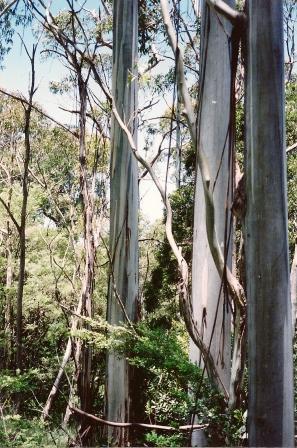Shining gum facts for kids
Quick facts for kids Shining gum |
|
|---|---|
 |
|
| Eucalyptus nitens - New England National Park, NSW | |
| Scientific classification | |
| Genus: |
Eucalyptus
|
| Species: |
nitens
|
| Synonyms | |
|
Eucalyptus goniocalyx var. nitens H.Deane & Maiden |
|
Eucalyptus nitens, commonly known as shining gum or silvertop, is a very tall tree found in Victoria and eastern New South Wales, Australia. It has smooth, grey bark and long, shiny green leaves. Its flowers are white, and its fruits look like small cups or barrels. This tree loves to grow in wet forests and near rainforests, especially in cool, rainy places with good soil.
Contents
What the Shining Gum Looks Like
The shining gum is a very tall tree, often reaching heights of 70 meters (about 230 feet). Some can even grow up to 90 meters (about 295 feet) in Victoria! Unlike some other trees, it doesn't have a special woody lump at its base called a lignotuber.
Bark and Leaves
Its bark is usually smooth and can be white, grey, or yellow. Sometimes, near the bottom of the tree, the bark is a bit rough and flaky. The smooth bark peels off in long strips.
Young shining gum plants have leaves that sit directly on the stem without a stalk. These leaves are shaped like a spear, an egg, or a heart, and are about 65-110 mm long and 28-55 mm wide. Adult leaves are glossy green and shaped like a spear or slightly curved. They are much longer, from 100-300 mm, and 15-40 mm wide. These adult leaves have a stalk, called a petiole, that is 10-40 mm long.
Flowers and Fruit
The flowers of the shining gum are white. They grow in groups of seven in the leaf axils (the spot where a leaf meets the stem). Each group of flowers grows on a small stalk called a peduncle, which is 5-15 mm long. The flower buds are oval or cylinder-shaped, about 6-7 mm long. They have a cone-shaped cap, called an operculum, that covers the flower parts before it blooms.
Shining gum trees usually flower from January to March. After flowering, they produce woody fruits. These fruits are shaped like a cylinder, a cup, or a barrel, and are about 4-7 mm long and wide. They are a type of capsule, which means they open to release seeds.
How it Got its Name
The shining gum was first officially described in 1899 by two scientists, Henry Deane and Joseph Maiden. They first called it Eucalyptus goniocalyx var. nitens. Later, in 1913, Maiden decided it was special enough to be its own species, so he changed its name to E. nitens.
The word nitens comes from Latin and means "shining." This name was chosen because the leaves, flower buds, fruit, and even the bark of this tree often look shiny.
Where the Shining Gum Grows
You can find Eucalyptus nitens in Victoria, especially in the high mountains and ranges east and north-east of Melbourne. It also grows on the high plateaus and mountains of southern New South Wales. There are also two smaller groups of these trees growing far away from the main populations, high up (around 1500 meters or 4,900 feet) near Barrington Tops and Ebor in north-eastern New South Wales.
What the Shining Gum is Used For
In Tasmania, the shining gum is a very important tree for plantations, which are like tree farms. Other important plantation trees there include the Tasmanian blue gum and Monterey pine.
The wood from the shining gum is mostly used for general building and construction. However, people are starting to use it more for making furniture. Sometimes, the natural color changes in the wood make the furniture look unique and interesting.
Is it Harmful?
Scientists have studied extracts from the leaves of Eucalyptus nitens. They found that these extracts can be harmful to very tiny sea creatures called mollusc larvae. Also, we know that eucalyptus oil, which comes from the leaves of many eucalypt trees, can be toxic and has properties that fight germs.
There were some concerns raised about foam found in a river in Tasmania that supplied drinking water. Studies showed this foam could harm water fleas, mollusc larvae, and even human cells in lab tests. However, later studies by health experts found no clear evidence that people drinking water from this river were less healthy than others.
It was also suggested that Eucalyptus nitens plantations might be the source of these harmful substances. But, foam samples from natural forests, where there were no plantations or shining gums, were found to be similarly harmful. This means these natural substances can become very concentrated in river foam.
A group of top scientists reviewed all the information. They found that the water quality of the George River was excellent. They also concluded that any worries about harmful substances in the water foam were mostly due to mistakes in how the samples were collected for the earlier studies.
As a safety step, a special water purification system was added to the water treatment plant in St Helens, Tasmania. Health officials stated that there was no scientific proof the drinking water was unsafe before this system was put in place.
See also
 In Spanish: Eucalyptus nitens para niños
In Spanish: Eucalyptus nitens para niños

